Recent Water Damage Posts
Understanding 5 Types of Weather-Induced Water Damage
2/13/2024 (Permalink)
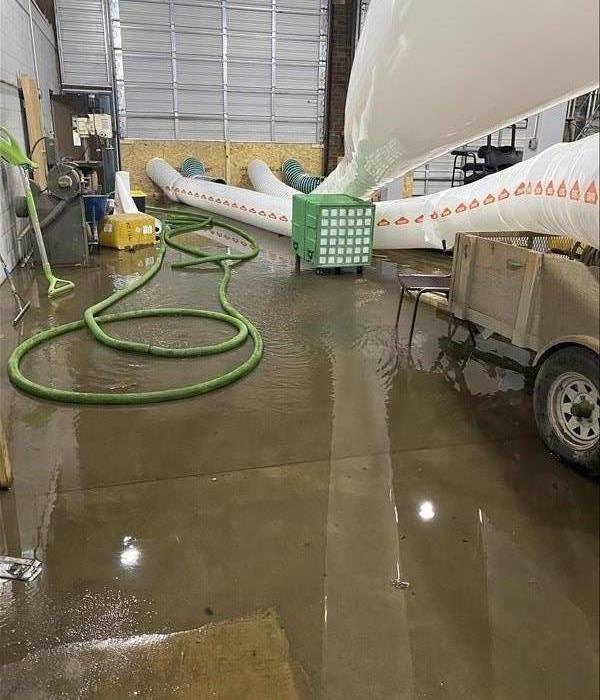 In this blog, we'll explore 5 different types of water damage caused by weather hazards and how to address each effectively.
In this blog, we'll explore 5 different types of water damage caused by weather hazards and how to address each effectively.
Weather hazards can wreak havoc on homes, causing various types of water damage that demand prompt attention and restoration. Understanding some of the most common forms of water damage resulting from weather-related events is important for homeowners in order to be prepared. In this blog, we'll explore 5 different types of water damage caused by weather hazards and how to address each effectively.
1. Flood Damage
Floods are among the most common weather-related water damage occurrences. They result from heavy rainfall, storm surges, or overflowing bodies of water. Floodwaters can penetrate homes, causing extensive damage to structures, belongings, and electrical systems. Quick extraction, drying, and decontamination are crucial after a flood to prevent mold growth and structural issues.
2. Storm Damage
Severe storms, including hurricanes, tornadoes, and windstorms, can cause roof damage, broken windows, and structural breaches, allowing rainwater to infiltrate homes. Storm-related water damage often necessitates immediate repairs to prevent further water intrusion and structural deterioration.
3. Hail Damage
Hailstorms can puncture roofs, siding, and windows, leading to water leaks. Even small-sized hail can cause damage to roofing materials, creating vulnerabilities that allow water to seep into the home. Timely roof inspections and repairs after hailstorms are essential to prevent water damage.
4. Snow and Ice Damage
Snow and ice accumulation on roofs can result in ice dams, causing water to seep under shingles and into the home. Additionally, thawing snow and ice can overwhelm drainage systems, leading to water infiltration. Proper insulation, ventilation, and maintenance of roofing systems can mitigate snow and ice-related water damage.
5. Lightning Strikes and Electrical Damage
Lightning strikes during storms can cause power surges, leading to electrical fires or damage to appliances and wiring. Water damage can occur from extinguishing fires caused by electrical malfunctions. Prompt assessment of electrical systems and appliances is vital after lightning strikes to prevent potential water and fire damage.
Weather hazards can bring various types of water damage, each requiring specific approaches to restoration. From floods to storm-related issues and electrical damage, understanding the distinct forms of water damage caused by weather events empowers homeowners to take proactive measures and seek timely restoration assistance.
At SERVPRO of Monroe, Randolph & Washington Counties, we specialize in mitigating and restoring water damage caused by weather-related events. Our experienced team utilizes advanced techniques and equipment to address different types of water damage effectively. Call us today for professional assistance in restoring your home after weather-induced water damage!
How Weather Conditions Can Increase Water Damage Risks
10/8/2023 (Permalink)
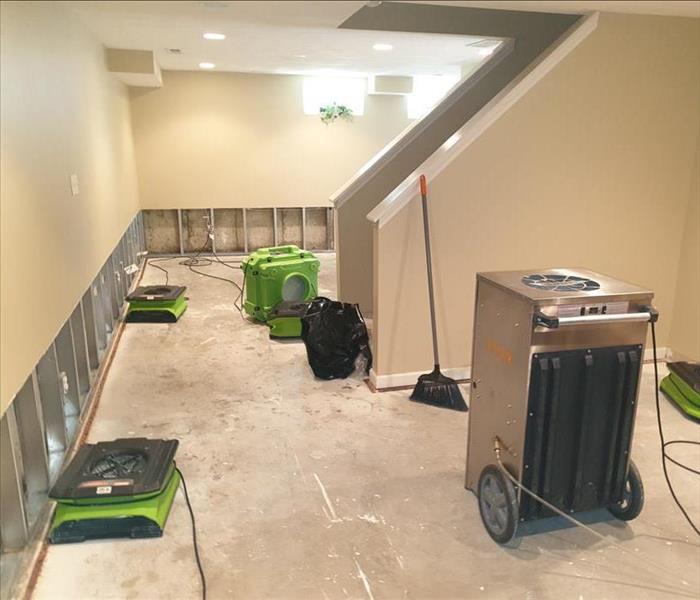 Understanding how weather conditions impact water damage risks in Illinois is essential for property owners.
Understanding how weather conditions impact water damage risks in Illinois is essential for property owners.
When it comes to water damage, understanding the role of weather conditions is crucial for homeowners and businesses alike. The Millstadt, IL, area experiences a wide range of weather patterns, from heavy rainfall to freezing winters, and each can pose unique risks. In this blog, we'll delve into how weather conditions affect water damage risks in Illinois, providing essential insights to help you protect your property.
1. Heavy Rainfall and Flooding
Illinois is no stranger to heavy rains, especially during the spring and summer months. Excessive rainfall can lead to flooding, which is a significant risk for property damage. Floodwaters can infiltrate basements, damage foundations, and ruin belongings. It's essential to have proper drainage systems and flood preparedness in place.
2. Freezing Temperatures and Burst Pipes
Winters in Illinois can be harsh, with freezing temperatures and snowfall. When water freezes, it expands, which can lead to burst pipes. Burst pipes can result in extensive water damage when temperatures rise and the ice thaws. Proper insulation and maintenance of plumbing systems are crucial to prevent this risk.
3. Ice Dams on Roofs
In the winter, ice dams can form on roofs when snow melts and refreezes near the roof's edge. This can lead to water infiltration, damaging ceilings, walls, and insulation. Adequate insulation and ventilation can help prevent ice dams from forming.
4. Thunderstorms and Lightning
Summer thunderstorms in Illinois can bring heavy rains and lightning strikes. Lightning can damage electrical systems and potentially cause fires. Water damage can occur when heavy rains accompany thunderstorms, leading to leaks or flooding.
5. Hail and Roof Damage
Hailstorms can be destructive, causing damage to roofs and siding. Damaged roofing materials can allow water to seep into your home, resulting in water damage. Regular roof inspections and repairs are essential to prevent this risk.
6. Spring Thaws and Rapid Snowmelt
As winter transitions into spring, rapid snowmelt can occur. When large volumes of snow and ice melt quickly, it can overwhelm drainage systems and lead to flooding. Ensuring proper drainage and maintaining gutters and downspouts is crucial during this time.
Understanding how weather conditions impact water damage risks in Illinois is essential for property owners. By being prepared and taking preventative measures, you can minimize the risk of water damage to your home or business. If you ever find yourself facing water damage, remember that SERVPRO of Monroe, Randolph & Washington Counties is here to assist Illinois residents with professional cleanup and restoration services. We're committed to helping you restore your property to its pre-damage condition, no matter the weather conditions.
The Sewage Damage Process: Steps to Address and Restore Sewage
7/24/2023 (Permalink)
Dealing with sewage damage can be a daunting and unpleasant experience. Sewage backups or leaks can cause significant damage to your property and pose health risks. Understanding the sewage damage process and taking immediate action is crucial to minimize further damage and ensure a safe and thorough restoration. In this blog post, we will guide you through the steps involved in addressing and restoring sewage-related issues.
Ensure Safety
Before addressing sewage damage, prioritize your safety. Sewage contains harmful bacteria, viruses, and other contaminants. Wear protective gear, such as gloves, boots, goggles, and a mask, to avoid direct contact with the sewage. If the damage is extensive or involves hazardous materials, it's best to contact a professional sewage damage restoration company.
Stop the Source and Assess the Damage
If you have a sewage backup or leak, it's important to stop the source as soon as possible. Locate the main sewage valve and shut it off to prevent further flow. Once the source is controlled, assess the extent of the damage. Take photos or videos of the affected areas for insurance purposes and to document the initial condition.
Call a Professional Sewage Damage Restoration Company
Sewage damage requires specialized expertise and equipment to ensure proper cleanup, decontamination, and restoration. Contact a professional sewage damage restoration company immediately. They have the necessary knowledge and experience to handle sewage-related issues safely and effectively.
Water Extraction and Cleanup
The first step in the sewage damage restoration process is the removal of standing water and sewage. The restoration professionals will use powerful pumps and extraction equipment to remove the water from your property. They will also dispose of any contaminated materials that cannot be salvaged.
After water extraction, thorough decontamination and disinfection of the affected areas are essential. Professionals will use industrial-strength cleaning agents and antimicrobial treatments to kill bacteria, viruses, and fungi. They will sanitize and deodorize the surfaces to eliminate odors and prevent mold growth.
Structural Drying
Once the affected areas are cleaned and disinfected, the drying process begins. Restoration professionals will use specialized drying equipment, such as dehumidifiers and air movers, to remove moisture from the structure and prevent secondary damage. They will monitor moisture levels regularly to ensure complete drying.
After the affected areas are thoroughly dried, restoration work can begin. This includes repairing or replacing damaged materials, such as flooring, drywall, and insulation. Restoration professionals will restore your property to its pre-damage condition, ensuring that all structural elements and systems are functioning properly.
Communicate with Your Insurance Company
Contact your insurance company as soon as possible to report the sewage damage. Provide them with the necessary documentation, including photos, videos, and invoices from the restoration company. Follow their instructions for filing a claim and keep a record of all communication for reference.
Addressing sewage damage requires swift action, professional expertise, and proper restoration techniques. By following the steps outlined in this blog post, you can effectively navigate the sewage damage process and ensure a thorough cleanup and restoration. Remember to prioritize safety, contact professionals promptly, document the damage, and communicate with your insurance company. With the help of experienced restoration professionals, you can restore your property and create a safe and healthy environment once again.
Beyond the Surface: Understanding Secondary Damage from Water Damage
3/12/2023 (Permalink)
Water damage can be one of the most frustrating and costly problems for homeowners. While it’s important to address water damage as soon as possible to prevent further damage, there is another type of damage that can occur: secondary damage. In this blog, we’ll explore what secondary damage is, and how it can occur in relation to water damage.
What is Secondary Damage?
Secondary damage is any additional damage that occurs as a result of the primary damage. In the case of water damage, primary damage is the initial damage caused by water, such as the damage to the structure, floors, walls, and personal belongings. Secondary damage, on the other hand, is the damage that occurs as a result of not properly addressing the primary damage.
How Does Secondary Damage Occur with Water Damage?
Secondary damage can occur in various ways after water damage. Here are some common examples:
- Mold Growth: Mold can grow in damp areas, such as carpets, drywall, and furniture, within 24-48 hours of exposure to water. If not properly addressed, mold can spread quickly and cause significant damage to your home.
- Structural Damage: If the water damage is severe enough, it can weaken the structural integrity of your home. Over time, the moisture can cause the wood to rot, and the metal to corrode, which can lead to structural failure.
- Electrical Damage: Water can damage electrical systems and pose safety hazards. If water comes into contact with electrical outlets, appliances, or wiring, it can cause shorts or electrical fires.
- Odor Damage: If the water damage is not addressed promptly, it can lead to unpleasant odors that can be difficult to remove.
How to Prevent Secondary Damage
The best way to prevent secondary damage is to address water damage promptly and properly. Here are some tips:
- Remove Standing Water: If there is standing water in your home, it’s important to remove it as soon as possible. Use a wet/dry vacuum or hire a professional to do the job.
- Dry the Affected Areas: After removing the standing water, it’s important to dry the affected areas thoroughly using dehumidifiers, fans, and other drying equipment.
- Clean and Disinfect: Clean and disinfect the affected areas to prevent mold growth and remove any potential hazards.
- Inspect for Structural Damage: If you suspect structural damage, have your home inspected by a professional to identify any potential issues.
In conclusion, secondary damage can occur as a result of not properly addressing water damage. By addressing water damage promptly and properly, you can prevent secondary damage and avoid costly repairs. Remember to always consult with a professional water damage restoration company to ensure that your home is restored to its preloss condition.
What To Do If Your Toilet Overflows
2/16/2023 (Permalink)
If you have a toilet that's overflowing, it can be a scary and stressful experience. However, there are steps that you can take to stop the water and clean up the mess. Here's what to do if your toilet overflows.
Do Not Flush Again
If your toilet is overflowing, the last thing you should do is flush it again. It's best not to let anyone get near that water until the situation has been dealt with.
If there are any other people in your home who aren't aware of what's happened yet, make sure they know about it immediately so they don't walk into their bathrooms and find themselves ankle-deep in toilet water!
Turn Off the Water to the Toilet
The next step in dealing with a toilet overflow is to turn off the water supply at the shut-off valve. This will prevent further flooding and damage. The toilet's water shut-off valve is usually located at the bottom of or behind your toilet. If you cannot locate the shut-off valve, try shutting off the main water valve to your home.
Typically, you'll find your house's main shut-off valve in either:
- A basement
- A garage
- The laundry room
Make sure that you have turned off all water sources in your home before doing any cleaning or repairs.
Clean Up Water
Next, you need to clean up any excess water from the floor and remove any damaged items from your bathroom. Use a sponge, towel, or mop to soak up any remaining water on the floor and wipe down any surfaces that were splashed with water.
It is important to remove the water as quickly as possible in order to prevent more damage from occurring on your property.
Disinfect Surfaces
Next, wipe down any surfaces that came into contact with water disinfectant cleaner so that no harmful organisms are left behind when you're done cleaning up your mess.
Disinfection is important because it can prevent the spread of bacteria and viruses. Make sure you disinfect all surfaces in your bathroom, including the toilet seat and lid, flooring around the toilet, and any other items that may have come into contact with the water.
Unclog The Toilet
Lastly, you need to unclog the toilet. Try plunging the toilet first. Be sure not to use too much force—you don't want to push any blockage further down into your pipes. If this doesn't work, you can try using a toilet snake to unclog the toilet. If this doesn't work or if you don't have any plumbing tools on hand, you'll need to call a professional plumber to fix the problem.
If This Fails, Call the Professionals for Help
If these steps didn't help, call a professional. If the damage is too extensive for you to handle on your own, it's time to call in reinforcements.
Hopefully, this article has given you more insight into the steps to take if you ever experience an overflowing toilet. SERVPRO of Monroe, Randolph & Washington Counties is always on standby and ready to help if your home or business has suffered from water damage due to a toilet overflow.
How to Categorize Your Water Damage
4/7/2022 (Permalink)
There are different types of water damage, some more harmful than others. Knowing about the different kinds is essential to keeping yourself safe when a water disaster hits your home or business. While you may be thinking, “It’s not like I’m going to drink the flood water in my basement,” it is more than just ingesting the water that can cause harm.
Category 1 Water
Category 1 Water is the cleanest. It refers to water that does not pose substantial threat to humans and is classified as “clean water”. Examples include water supply lines, tub or sink overflows, or appliance malfunctions that involve a water supply line.
Category 2 Water
Category 2 Water is the kind you need to watch out for. Known as “grey water”, this kind refers to a source of water that contains a significant degree of chemical, biological, or physical contaminants. This kind of water can cause discomfort or sickness when consumed or even exposed to. Grey water carries microorganisms and nutrients of microorganisms. Examples are toilet bowls, sump pump failures, and water discharge from dishwashers or washing machines.
Category 3 Water
Category 3 Water is grossly unsanitary. It is known as “black water” and can contain unsanitary agents and harmful bacteria and fungi. Being exposed to or ingesting black water can cause health issues. Category 3 Water refers to water sources that affect the indoor environment. This category includes water sources from sewage, seawater, rising water from rivers or streams, ground surface water, or standing water. Category 2 Water that is not promptly removed form the structure and/or has remained stagnant may be reclassified as Category 3 Water. Toilet back flows that originates from beyond the toilet trap is considered black water contamination.
SERVPRO of Monroe, Randolph & Washington Counties wants you to be informed of the dangers of water and the kind of damage it can cause. We can handle any kind of water damage your home or business has, making it “Like it never even happened.” If your home or business suffers from water damage, call the experts at (618) 464-0300.
Get the 411 on Preventative Steps for your Water Heater
4/6/2022 (Permalink)
We use our water heaters tirelessly. Whether it comes to cleaning dishes, taking showers, or washing hands, we rely on them to fulfill our hot water needs. If not properly maintained, these devices can not only be unable to heat water, but can break and fill your home with water. However, with the right preventative steps, you can avoid this altogether.
Lifespan
Your average hot water heater has a lifespan of about 10 years. If not replaced in this time, it can start to slow down and not heat water as fast, or shoot water around your home due to leaks and breaks. It is a good idea to have your water heater replaced about every 10 years.
Parts
Hot water heaters aren’t perfect and can often have problems other than being too old. Sometimes, heavily-used parts of the machine, like gaskets, can rust or wear down, causing leaks. Frequently check your water heater for any signs of damage or rust to any parts.
Signs (Not the Movie)
There are a few ways that you can tell if your hot water heater has deteriorating components:
- Strange color of hot water
- Strange odor of hot water
- Leaks
- Strange noises coming from the machine
If you stay vigilant when it comes to your hot water heater, you can enjoy years without hot water heater incidents or water damage. We at SERVPRO want homeowners and business owners to know the risks and preventative measures when dealing with hot water heaters so you don’t run into disaster.
If you do have water damage due to a hot water heater malfunction, call your local SERVPRO of Monroe, Randolph & Washington Counties 24/7 at (618) 464-0300.
April Showers bring May Flowers and Overwhelmed Sump Pumps
4/1/2022 (Permalink)
April Showers!
It is officially April which means April showers are upon us! Excessive rain can be good for some plants, but not so great for your home. Flood damage can occur, basements can be flooded, and home exteriors can suffer. SERVPRO has all the tools needed to clean up any flood disaster!
We Have the Know-How
We at SERVPRO follow strict industry standards when it comes to recovering your home from flood damage. With our state-of-the-art drying equipment and techniques, we can quickly and efficiently return your home or business back to pre-disaster condition. SERVPRO also provides a 24/7 emergency response service so we can assist with your water disaster any time, day or night.
If your home or business has flood damage due to the coming rain, call SERVPRO of Monroe, Randolph & Washington Counties at (618) 464-0300.
24 Hour Emergency Water Damage Service
3/2/2022 (Permalink)
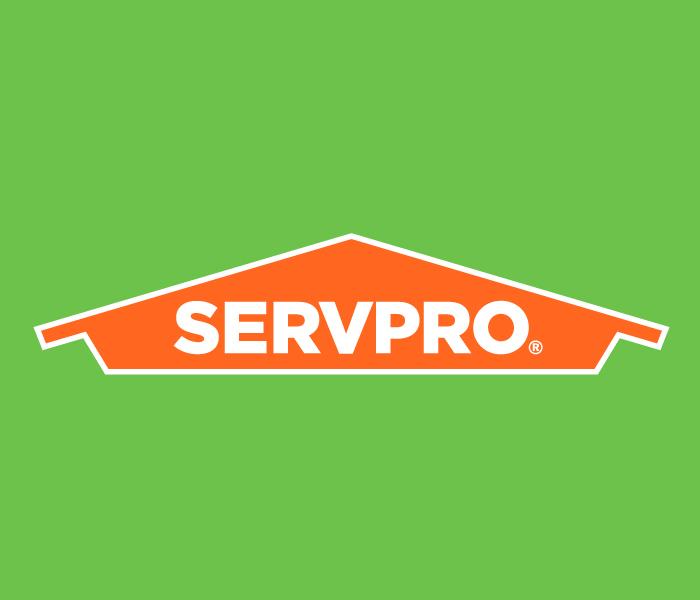 Just a phone call away, 24 hours a day - SERVPRO of Monroe, Randolph, and Washington Counties 618-464-0300
Just a phone call away, 24 hours a day - SERVPRO of Monroe, Randolph, and Washington Counties 618-464-0300
SERVPRO of Monroe, Randolph and Washington Counties is available 24 hours a day for water emergencies, large or small. When you are dealing with water damage, immediate action is crucial. A delay of just a few hours can greatly increase the severity of the water damage.
We Answer the Phone Ready to Help
Call Today - 618-464-0300
We understand that when you call us, you may be feeling confused, stressed, and vulnerable. You need an expert to guide you through this crisis. SERVPRO of Monroe, Randolph & Washington Counties has the specific water damage training and experience to help you through this tough time. We specialize in water damage restoration—in fact, it's the cornerstone of our business.
What to Expect
When you call, we will ask several questions regarding your water damage emergency. These questions will help us determine what equipment and resources to bring, including how many trained SERVPRO Professionals may be needed.
Our SERVPRO Representative will ask several questions:
- Your name and contact information
- Your insurance information (if applicable)
- The street address of the water-damaged home or business
- When did the flooding or water damage occur?
- What caused the water damage (if known)?
- Is there electricity available (on-site)?
About SERVPRO of Monroe, Randolph and Washington Counties
SERVPRO of Monroe, Randolph and Washington Counties specializes in the cleanup and restoration of residential and commercial property after a fire, smoke or water damage event. Our staff is highly trained in property damage restoration. From initial and ongoing training at SERVPRO’s corporate training facility to regular IICRC-industry certification, rest assured our staff is equipped with the knowledge to restore your property.
There Is A Science To Drying Water Damage
1/18/2022 (Permalink)
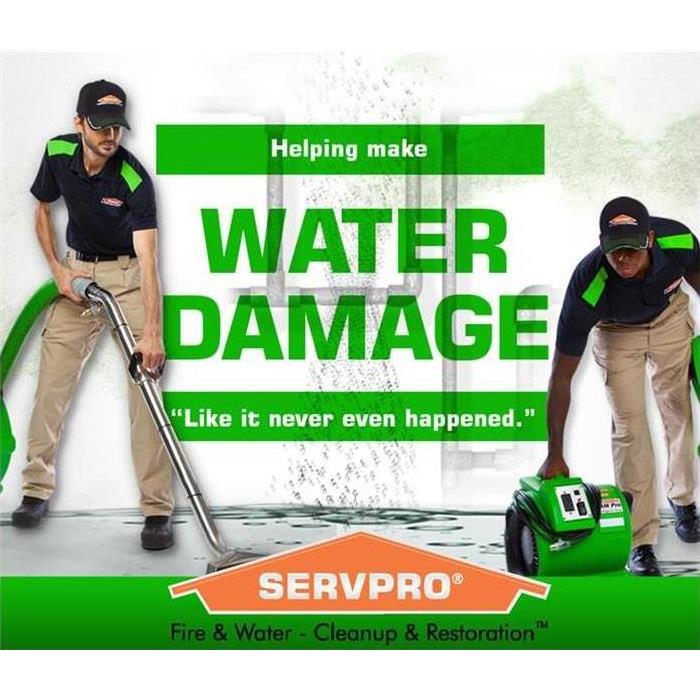 When life hands you water damage, make sure to call the Pros. SERVPRO of Monroe, Randolph and Washington Counties 618-464-0300
When life hands you water damage, make sure to call the Pros. SERVPRO of Monroe, Randolph and Washington Counties 618-464-0300
As simple as it may seem, there is actually a science behind drying. Psychrometrics is the study of physical and thermodynamic properties of gas-vapor mixtures and is the fundamental science backing our drying processes. Some may think it is sufficient just to lay down towels or place a fan in front of affected areas, but that could allow deep-set water to cause damage without you knowing. Let the experts handle your water issues.
We Have the Know-How
We at SERVPRO follow strict industry standards when it comes to recovering your home from water damage. With our state-of-the-art drying equipment and techniques, we can quickly and efficiently return your home or business back to pre-disaster condition. SERVPRO also provides a 24/7 emergency response service so we can assist with your water disaster any time, day or night.
If your home or business has water damage, call SERVPRO of Monroe, Randolph & Washington Counties at (618) 464-0300.
Basement flooded? Call SERVPRO of Monroe, Randolph, and Washington Counties
1/7/2022 (Permalink)
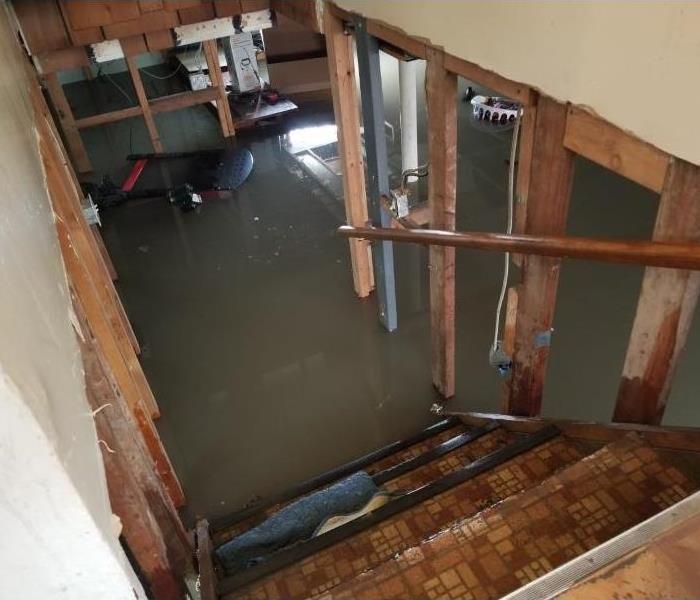 If your basement looks like a swimming pool, don't stress. Call your local SERVPRO at 618-464-0300
If your basement looks like a swimming pool, don't stress. Call your local SERVPRO at 618-464-0300
A basement can flood at any time, although flooding most often occurs during heavy rainfall. Basements are inherently prone to flooding because they are the lowest level of a building and are normally built partly or entirely below ground level. There are several reasons why your basement could flood, including:
- A blocked or failed sewer lateral pipe
- Heavy rain causes surface water to pool around your home
- Storm sewer backup
- Sanitary sewer backup
- Foundation drainage failure
- Water supply-line break or hot-water tank failure
- And many more
If flood water is not handled quickly and properly, it can jeopardize your health and safety, and cause severe damage to your home’s structure. Remember, the longer you wait, the worse the problem will get.
The bottom line: a flooded basement can jeopardize your health, safety, and your home’s integrity. It’s worth making a call to SERVPRO of Monroe, Randolph and Washington Counties and let our trained, professional crews handle the situation safely and correctly. We have earned the trust of hundreds of homeowners, business owners, and property professionals.
We are Flooded Basement Specialists:
- We are Available 24 hours/7 days per week
- We’re a Preferred Vendor to many National Insurance Companies
- We Bill Your Insurance Directly – One Less Thing for You to Worry About
- Our technicians are Highly Trained in Water Restoration Techniques
- We use s500 IICRC Restoration Standards
- Advanced Inspection and Extraction Equipment
Basement Flooded? Call Us Today – We’re Ready To Help 618-464-0300
 In this blog, we'll explore 5 different types of water damage caused by weather hazards and how to address each effectively.
In this blog, we'll explore 5 different types of water damage caused by weather hazards and how to address each effectively.

 24/7 Emergency Service
24/7 Emergency Service



